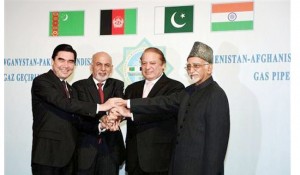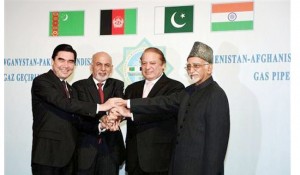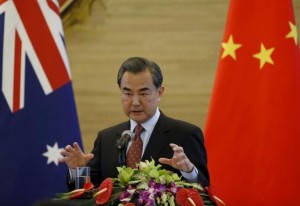Muhammad Saeed
The key for peace and prosperity of South Asia region is broadly viewed as dependent on the utilization of its natural resources and exploitation of the human resources. In this context, Afghanistan would remain the focal point of concern, due to her specific strategic location and current security situation and its negative fall out in the region and beyond. Despite of the drastic and unimaginable risks involved even in taking up any minor project in Afghanistan, the initiative of a mega project like the TAPI gas pipe line project is commendable. However, all its success contours are solely dependent on the response and future implementation of Afghanistan. This initiative, itself is reminder of a converging confidence among stakeholders; needing commendable and appreciable gestures of the countries involved in the project. The proposed plan for a new natural gas pipeline may augment the way forward for the intended economic boom of Afghanistan. However, the Afghan Government needs to implement real pathways for its success. In 2015, the countries including Turkmenistan, Afghanistan, Pakistan and India ,converged for going ahead to construct the mega project named as TAPI, carrying natural gas through pipeline from Turkmenistan passing through Afghanistan to ,Pakistan and India. The project finally came out of cocoon of doubts and deliberations during 2015 and shifted from theoretical concept to pragmatic initiative. Afghan nation is desperate to transform their country into a major trade and energy corridor. Pakistan and India are starving for supplementary energy to augment the prosperity , whereas Turkmenistan is also seeking to diversify its gas markets. These converging aims could add up efforts to configure a joint strategy to tackle common challenges and economic interests of stakeholders and other regional countries.
The progress on the project is generally attributed to three major breakthroughs: an agreement on the TAPI holding company’s share structure, the selection of a leader for the consortium, and the groundbreaking ceremony. The ceremony, held in Mary, Turkmenistan on Dec13, delivered a strong message to the skeptics. Yet others saw TAPI as only a minor item on the agenda during conferences and academic discussions. However, these recent actions have catapulted TAPI to South Asia’s center stage, as it becomes clear that the pipeline could develop into a major, much needed source of energy and stability for Afghanistan and the region. TAPI, a 1,127-mile long pipeline, would transport 24 million metric tons (MMTs) of natural gas from Turkmenistan’s gigantic Galkynysh field, the second largest gas field in the world; to Afghanistan, Pakistan, and India. TAPI will provide Afghanistan with .365 to 1.095 MMTs per year over the next 30 years, while India and Pakistan will each receive 10.2 to11.7 MMTs per year.
Afghans in Kabul, Nangarhar, Herat and Kandahar heartily greeted it by gathering and demonstrating their joy over the pipeline’s groundbreaking ceremony. Experts believe that President Ashraf Ghani’s visualization of Afghanistan as emerging to assume her historical dominance as one of Asia’s key trade routes seems achievable during short span of his president ship. The Afghans have also largely supported the project. They believe that projects like TAPI will remove the economic shackles that have limited Afghanistan’s growth as a normal and prosperous country ,during the last 40 years of divergence. The widespread support from pro and anti government groups alike, signaled that the security concerns linked to the construction of TAPI, which many once believed to be major impediments, are manageable. During President Ghani’s previous visit to Kandahar on 3 Feb16, the province’s elders vowed to protect the TAPI pipeline by all means necessary, which was considered a very positive and healthy indicator of future prospects regarding safety and smooth functioning of the pipe line in the region. It is estimated by the experts that Afghanistan would benefit tremendously from TAPI, and the $400 million in annual transit fees is not the only outcome but apart from serving as a reliable source of cheap green energy to support the country’s economic growth, Afghanistan’s Ministry of Mines and Petroleum (MoMP) estimates that TAPI would contribute considerably to Afghanistan’s GDP, and provide jobs to at least 25,000 Afghans.
The resultant benefits could be utilized by the Afghan government to control the growing unemployment rate that has led young Afghans to pursue job prospects in Europe and other foreign countries. Besides, such more developmental mega projects should be initiated with the help of international and regional community for keeping an environment of honest struggle and positive impacts on the daily lives of the general public, as Afghans are otherwise very resilient and hardworking specie. The implementation of TAPI project could also offer Afghanistan the collaboration of key allies and working jointly for supporting Afghanistan’s security and political stability, as the pipeline’s large portion would run through Afghanistan as a valuable asset of the stakeholders.
Experts are of the opinion that to utilize TAPI’s gas in Afghanistan, three electricity-generating Independent Power Producers (IPPs) with 100 MW capacities could be built in Helmand, Herat, and Kandahar. Construction of three IPPs could proceed through a public-private partnership (PPP) model involving the government and private sector. This design was used for IPPs in Sheberghan (200 MW), the capital city of Jowzjan province in northwest Afghanistan, and Mazar (50 MW), the capital of Balkh province also in northwest Afghanistan. However, both have yet to be built, and only the Mazar IPP have so far attracted an investor, being facilitated by the World Bank’s International Finance Corporation to proceed with financing. Building these three IPPs for TAPI could address the energy needs in Kandahar, Helmand, Nimruz, Uruzgan, Farah, and Herat. it is estimated that in Helmand province of Afghanistan remains one of the largest sources of illegal drugs in the world. The Afghan government could convert the region’s economic engine from opium production to manufacturing, made possible through the reliable power and electricity provided by TAPI. While Afghanistan can’t get enough energy, Turkmenistan can’t sell enough gas. TAPI gained momentum in 2015 in part because of the P5+1 and Iran nuclear agreement that lifted sanctions on Iran and opened the possibility of an Iran Pakistan India (IPI) pipeline. Turkmenistan feared that any gas pipeline from Iran to South Asia could undermine its plan to diversify its gas exports. The TAPI project could play a pivotal role in diversifying the market for Turkmenistan’s gas exports, and these opportunities have the potential to double Turkmenistan’s revenues.
Security experts view that despite the positive developments, TAPI still faces some intimidating hurdles. Aside from the structural challenges; inherent in the Turkmen economy, the most momentous impediment is Afghanistan’s lack of adequate military capacity to secure its segment of the pipeline. However, it is widely agreed that the proposed pipeline could be protected with sufficient monetary expenses on pipeline security measures in conjunction with the political and diplomatic settlements of inter and intra differences of stake holders of the project. Besides, placement of weathered personnel alongside Afghan security forces to implement them. However, that effort would likely require the commitment of the international players as well as the cooperation of the Afghan government. Pakistan has always approached and considered that “the enemies of Afghanistan are the enemies of Pakistan.” Yet, at the same time, the negativity created against Pakistan by the Indian lobby while exploiting the national and international forums to defame and discourage Pakistan; needs to be harnessed by the Afghan government for nurturing the intended bilateral relations between Pakistan and Afghanistan. Experts firmly believe that the entire purpose of the subject project is not only the economic interests of the participating countries but it would also augment; to establish a secure, stable and prosperous Afghanistan in a secure and stable region. However, in case of trying to create an atmosphere of mistrust by any adversary of peace and prosperity, all the regional and international countries must adopt a joint strategy to preempt and tackle any such negativity; which could damage the overall efforts of the regional and international countries for bringing global peace and stability.





